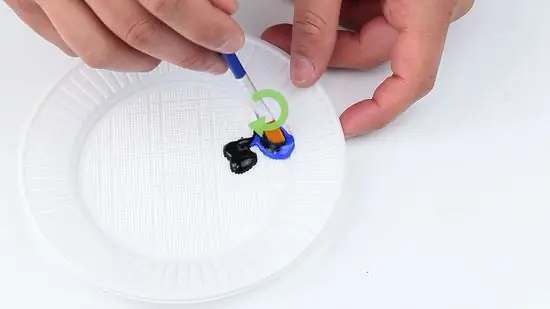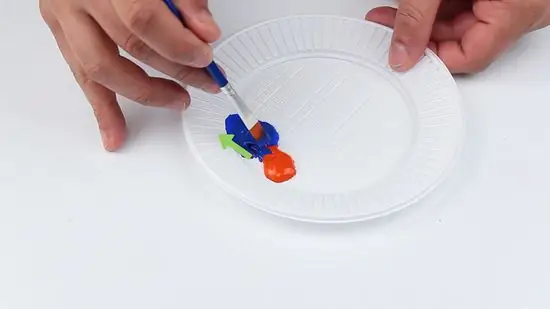- Author Jason Gerald [email protected].
- Public 2023-12-16 10:50.
- Last modified 2025-01-23 12:04.
Darker shades of blue can be created by mixing the blue you currently have with another color. Learning how to mix colors will expand the options you have for creating any project. There are several colors you can add to the blue to make it darker. Be careful when adding other colors to the blue, so you can create the perfect dark blue for your project.
Step
Method 1 of 3: Adding Black to Blue

Step 1. Pour the blue paint over the palette
Make sure the amount is sufficient for the entire project that you will work on. Once the hue of this paint mixture is to your liking, it can be difficult to create the same shades a second time. So it's better to make a sufficient amount of mixture than later you will run out of paint.
- If you can't finish the project all at once, store leftover paint in an airtight container, such as the plastic container you use to store leftovers.
- Place a damp paper towel or sponge at the bottom of the container, or use the Sta-Wet Palette to prevent the paint from drying.

Step 2. Pour a small amount of black paint next to the blue paint on the palette
Don't pour black paint directly on blue paint. By placing them to the side, you can add a little bit of black paint and make changing color shades more controllable.

Step 3. Drag the brush from the edge of the black paint blob and draw a small amount of black onto the blue
Don't add too much black paint the first time. Black is a very strong color and a small amount can have a big effect.

Step 4. Mix the black to blue paint little by little
Mix the two using a stirrer or brush in criss-cross directions. There's no need to mix it thoroughly because it will make the color dull. Just stir as necessary to assess the resulting nuance.

Step 5. Add black paint and stir as needed until you achieve your desired shade of blue
You may need to add black paint a few times, but keep doing it in small amounts so that it doesn't get too dark.
If you accidentally add too much black paint, just pour in some blue paint to balance the ratio
Method 2 of 3: Blending Complementary Colors

Step 1. Print the color wheel
The color wheel represents the primary colors red, yellow, and blue, and all the colors that can be created by combining these primary colors. There is a “base color wheel” that only displays primary and secondary colors. But it would be better if you print a more complete color wheel, which includes a variety of tones, hues, and shades.

Step 2. On the color wheel, find the exact position of the blue hue that you are using
To identify complementary colors, start with the exact position of blue on the color wheel. Don't judge hues based on paint labels. However, pour the paint on a piece of white paper and let it dry. Then compare these colors on the color wheel and match the hues to the most accurate part.

Step 3. Identify shades of orange that are complementary to your blue tones
Complementary colors are colors that are directly opposite the shades of blue on the color wheel. A complementary color to your blue is one of the colors on the color wheel orange, and this color will be mixed with blue to darken the tone.
- You can start by mixing burnt sienna (a rich orange-brown pigment) with ultramarine blue (warm blue).
- Other color combinations are cadmium orange (bright warm orange) and cobalt blue (clear mid blue pigment).

Step 4. Pour enough blue paint on the palette for the entire project to be worked on
It's better to make quite a lot of mix than later you'll run out of paint and have to make a mix of exactly the same shades a second time.
Set aside some of the blue paint as a reserve, in case you added too much orange and have to adjust the shades by adding blue to the mix

Step 5. Add a little bit of orange paint next to the blue paint on the palette
It's a good idea to place the orange paint next to the blue paint and stir it a little at a time. You may need a lot of dark blue paint, but to make the mixture, you don't need as much orange as blue paint.

Step 6. Drag the brush or palette knife from the edge of the orange paint blob onto the blue paint
Don't mix too much orange paint the first time. By adding it little by little, you will see how the orange changes the blue tones.

Step 7. Mix the orange paint with the blue paint
Mix the orange paint with the blue paint using a mixer such as a palette knife or brush in criss-cross directions. Using a complementary color will result in a bright dark blue, so don't add too much orange paint. Just add just enough to change the blue tone and keep the color from being dull.

Step 8. Add the orange paint little by little until you get the desired shade of blue
Avoid the urge to add a lot of orange paint. If the orange color is too much, the mixture will not be close to dark blue, but will have shades of orange. Add the orange little by little and work through the results until you get the perfect dark blue tone.
If you accidentally add too much orange, pour in some blue paint to balance the ratio
Method 3 of 3: Mixing Analog Colors to Create Color Combinations

Step 1. Pour the blue and purple paint onto the palette
Purple or violet is an analogue color to blue which is next to blue on the color wheel. Make sure you have enough paint. Blue paint as the base color should be more than purple paint.

Step 2. Mix a little purple to blue
You can use a brush or palette knife to stir it. Add purple paint little by little to control the color combination and create a violet-blue.

Step 3. Test the paint color
Many paints, including acrylic paints, will darken as they dry. Acrylic paint dries quickly, so you can easily test paint color by dabbing a small amount of paint onto the canvas and then letting it dry. It only takes about 15 minutes and you will see the results of the color, before using these color shades for the project to be worked on.
If you're not happy with the dry paint color, go back to the palette and adjust it by adding more blue or purple as needed
Tips
- Clean the palette after use to mix paint.
- Whichever method you use, always work under bright lighting to get the colors right.
Warning
- When mixing and applying paint, work in a well-ventilated area.
- If you're a beginner, it can be difficult to make the exact same color a second time. So make the mixture in sufficient quantities at once. As you get more experienced and with practice and a more used eye, it will become easier to recreate the same colors that were previously created.






